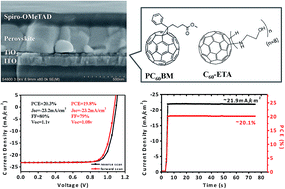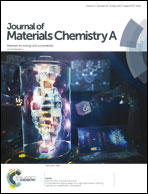Eliminated hysteresis and stabilized power output over 20% in planar heterojunction perovskite solar cells by compositional and surface modifications to the low-temperature-processed TiO2 layer†
Abstract
Fabrication of efficient, hysteresis-free perovskite solar cells with stabilized power output in a planar heterojunction configuration via a low-temperature solution process remains a big challenge. Herein, we report an effective approach to prepare high performance n–i–p type planar heterojunction perovskite solar cells with eliminated hysteresis and stabilized power output over 20% via compositional and surface modifications to a low-temperature-processed TiO2 electron-transport layer (ETL). The fullerene derivative layer between the ETL and perovskite layers significantly improves electron extraction and suppresses charge recombination by reducing trap density at the ETL interface. This work manifests the presence of diffused TiO2/fullerene and fullerene/perovskite interfaces as an efficient interfacial engineering strategy to prepare high-performing perovskite solar cells.



 Please wait while we load your content...
Please wait while we load your content...